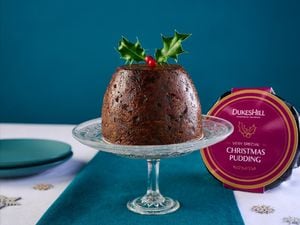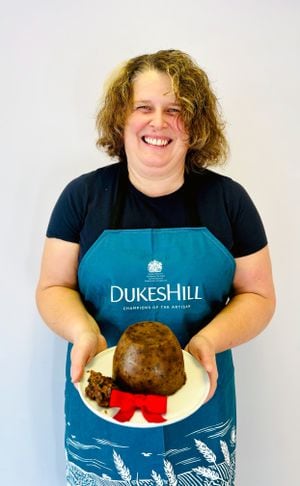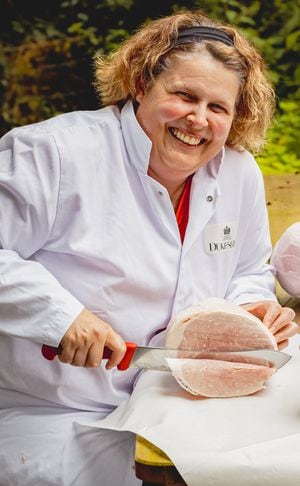Tradition is the key for a perfect Christmas pud, says Telford's master of puddings
It just wouldn’t be Christmas without a traditional pudding. And for many people, lighting this fruit-filled dessert is the perfect end to their celebratory meal.

Nicky Biddulph knows more than most about Christmas puddings.
For more than 17 years, she has worked at Telford-based DukesHill and, as well as her role as the production manager, she is also the master pudding maker.
“I oversee the production and quality of all our products, which have to be nothing short of the best. We test everything – and you never stop learning.
“That’s the reason why I’ve been here so long. I love my job, I love the passion that goes behind making these products.
“We hand produce everything, we don’t ‘process’ it. We may have a small team but we all have the same drive and passion,” she explains.
The business sells in excess of 7,000 puddings ever year, which are all made by Nicky and her team.
“We use 9.1kg currants per batch of Christmas puddings. We make 36 batches a year. That totals up to 328kg – which is around the same weight as two adult reindeers,” says Nicky, who lives in Wellington.
“Ingredients start arriving in January, but we start making the puddings around February time. This gives it plenty of time to develop and mature.”
When it comes to making a pudding from scratch, there are a lot of steps involved in the process.
“It all starts with selecting the right ingredients. Whilst we always make our traditional recipe, we spend significant time carefully sourcing high-quality dried fruits in bulk quantities,” says Nicky.

The ingredients for each Christmas pudding are mixed and weighed out by hand – this process alone takes up to three hours.
“Our puddings are a generous mix of dried fruit and spices, so there’s a lot to weigh and mix,” says Nicky.
“We make our puddings very much like you would at home. First, we thoroughly mix our fruits, flour and spices. The free-range eggs and alcohol are added gradually while stirring.
“We need to ensure we have a well-mixed, consistent batter, so every mouthful is varied.
“The mixed batter goes into the serving pots ready for steaming, which makes the fruit wonderfully plump and juicy.”
Steaming small and medium puddings takes four hours and the large ones take six hours.
“The factory smells incredible during this time – a heady, rich aroma of pure Christmas,” says Nicky.
“We then steep the puddings in French brandy and allow them to mature for 30 weeks, so it thoroughly soaks through.
“Finally, we wrap them beautifully, as they make a lovely gift,” she adds.
“Each step requires stringent quality control measures, as our customers have high expectations for our products.
“The DukesHill logo is our stamp of assurance that the product is exceptional, each and every time.”

For Nicky, the perfect Christmas pudding must be chock-full of fruit to give a dense, moist texture without being too solid.
“The plums originally referred to raisins, but I love a variety of fruit – cherries, mixed peel and sultanas – like fudgy jewels of different flavours and textures to delight each mouthful.
“DukesHill’s Christmas puddings use butter instead of suet, which not only makes the puddings vegetarian but also gives a much cleaner finish on the palate.
“When laced with brandy, you get that lovely warming edge that truly tastes like Christmas. It doesn’t matter how full I am, there’s always space for a glorious wedge of Christmas pudding and brandy butter to round off the meal.”
Lighting the pudding is a tradition that will take place in homes across the region on Monday and Nicky has shared her advice to help make the moment extra special.
“Nothing beats the theatre of turning the lights down, gathering everyone around and lighting the Christmas pudding,” she says. “Get prepared by reheating your pudding and getting a large spoon at the ready to use for basting. Also, heat up your serving jug by pouring boiling water into it.
“Pour three to four tablespoons of your favourite spirit into a saucepan. Crucially, it needs a high alcohol content for a guaranteed flame – the traditional choice is brandy.
“Personally, I use cherry brandy to compliment the cherries in our puddings.
“At this point, I like to get everyone around the table, which we all know is no mean feat, and as there’s no point warming the spirit until the last minute.
“Heat the spirit until it’s very hot. Tip away the hot water from your serving jug and immediately refill with the hot spirit. Then, pour the hot spirit over the warm pudding.
“Set fire to the pudding with a lighter or long match. Carefully baste the pudding with the spirit on the plate to the sound of oooohs and aaaahs.
“When the flames have disappeared, it’s ready to serve and enjoy!”





